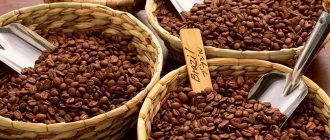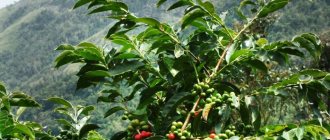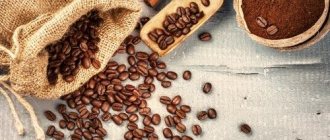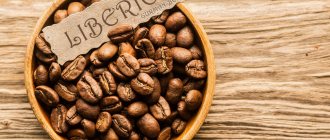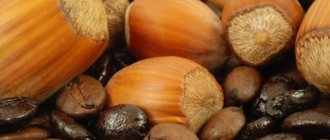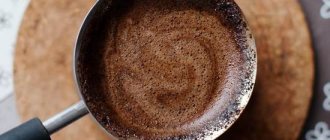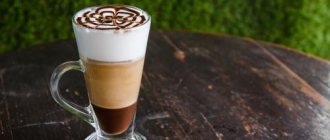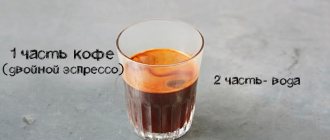Coffee appeared in Cuba in the mid-18th century thanks to French farmers who fled the revolution in Haiti. Plantations occupied the western plains, spreading to the foot of the mountains. In the eastern part, the coffee industry began to develop in the 19th and 20th centuries. In the 1950s, at the peak of its success, Cuba produced more than 20 thousand tons of coffee per year. After the Cuban revolution in 1959, coffee production was nationalized and gradually declined. In 2008, during the global economic crisis, indicators reached a minimum. The commodity that was once the country's main export now makes up only a small part of it.
92% of Cuban coffee is grown in the Sierra Maestra mountains; the state organization Cubaexport is responsible for the export of aromatic beans, which determines prices, quotas and other organizational issues.
Distinctive features of Cuban coffee addiction
What are the features of Cuban coffee and how does it differ from its counterparts from Italy and France? When planning to try this extraordinary drink, you need to know the following:
- For its preparation, only natural, extremely roasted grains grown exclusively in Cuba are used;
- the finished drink is very strong, traditionally drunk with a lot of sugar;
- Cuban coffee is served in small cups and washed down with cold water.
This drink has a tart, spicy taste and obligatory notes of bitterness due to the high caffeine content. Of course, to complete the feeling of merging with Cuba, you can complement the strong taste of coffee with a tart aromatic cigar, but this pleasure is not for everyone.
Cuban coffee traditions
Coffee came to Cuba in the 18th century, thanks to José Gelabert, who founded the first coffee production in 1748. The first grains were from Santo Domingo (Dominican Republic). The favorable climate and attentive attitude to cultivation technology were to the liking of the “newbie.” The impetus for the development of the coffee industry at the end of the 18th century was given by French colonists from the island of Haiti, who established extensive plantations.
And for more than 250 years, Cubans have been producing excellent coffee, recognized throughout the world. It is cultivated at lower altitudes (350-750 meters) than other main Arabica producers, therefore it has a richer taste, less sourness, and the presence of notes of chocolate, tobacco, and hot pepper.
Coffee in Cuba is prepared surprisingly strong and sweet according to the principle “more coffee with sugar, less water,” which is why it turns out thick and invigorating and so sweet that you can compare it to liqueur. They drink it from small cups very hot, most often with rum, adding it directly to the drink itself.
There are different recipes for making Cuban coffee. But no matter how the drink is prepared, it must amaze with its strength, taste and aroma - this is the main thing.
A little history
The cultivation of coffee trees has a history of more than two centuries. For the first time, seedlings were brought to Cuba from Haiti, and this was in the mid-18th century. Cubans approached tree growing with all responsibility. The strictest adherence to technology, supported by an excellent climate and fertile soils, has yielded amazing results.
Today, the concept of “Cuban coffee” combines several varieties of high-quality Arabica coffee. It is almost impossible to find a drink made from one type of bean outside of Cuba. Only mixed varieties are exported. For ease of understanding, regardless of the varietal composition, the package with the finished beans is labeled as “Cubita Coffee.”
Revolutionary souvenirs
The Cuban Revolution is the most striking symbol of the Island of Liberty, which will remain in the minds of people for a long time. Therefore, revolutionary-themed souvenirs are sold out quickly and willingly here. These may be products with prints of Cuban flags and revolutionary mottos, but the main “brand”, without a doubt, is Che Guevara. It is used on T-shirts, bags, beach towels and caps. Another popular souvenir is a headdress similar to what Che wore - you can buy it at the shops for 7-10 USD. In addition to standard factory-made accessories, there are also more interesting revolutionary souvenirs. For example, in one of the galleries in Trinidad I saw a painting for sale that was an allusion to the Last Supper, where Fidel sat at the head of the table instead of Jesus.
Where can I buy
As a rule, such products are brought to Cuba from China, and in souvenir shops their prices are unreasonably increased. Therefore, if you have the opportunity, go for such gifts to one of the souvenir markets in Havana. There you can buy revolutionary little things from 2 USD per piece.
What is the secret of extraordinary taste?
In addition to historical and climatic features, several other special factors influence the depth and taste of the rich Cuban drink:
- Each tree on Cuban plantations is provided with careful care. This approach allows you to get the maximum benefit from the soil and fertilizers for each harvest.
- The grains are extracted from the peel and pulp using a special technology, which minimizes damage.
- All grains undergo the most careful selection. They are sorted both by the number of defects (cracks, chips) and by size.
- Cuban roasting is recognized as the strongest. The grains are fried at a temperature of 250 degrees, and this adds its own notes to the taste of the finished drink.
- Real coffee from Cuba is stored in special vacuum packaging, but even then the shelf life of the beans is short.
To feel all the features of a drink with such an interesting history and production technology, you need to buy Cuban coffee beans at least once. Reviews from connoisseurs indicate that only in this form can all the qualities of the drink be preserved as much as possible.
Clothes and accessories
On the streets of tourist cities in Cuba, stalls with clothes line one after another. Most often, tourists buy it not so much as a gift, but for themselves. These are mainly items designed for hot weather - light linen dresses and trousers, straw hats and beach bags. Leather products are also sold, such as belts and backpacks. But I recommend that you sniff them carefully first, as many have a strong goat smell. Prices for products vary greatly in different regions - from 7-10 USD for an accessory and from 15-20 for a piece of clothing. Also, at each store, jewelry is sold: beads, bracelets and earrings made of nuts, seeds and coffee beans for 2-10 USD. These items significantly lift the spirits of travelers, because with such accessories you feel much more like you are vacationing in the Caribbean.
Where can I buy
Many people hope to purchase elements of authentic Cuban clothing in regular local stores. But I dare to disappoint you - city shopping centers are a very sad sight. The choice of clothing and accessories there is very small, and the assortment consists entirely of Chinese products. Therefore, you can only dress up in Cuban style in souvenir shops .
Popular varieties of Cuban drink
Despite many common and similar characteristics, gourmets around the world have identified several of the most popular varieties. Each of them has individual characteristics and can find its own connoisseur.
Altura and Trinidad are considered one of the most popular today. They are characterized by a high caffeine content, which gives the drink a characteristic bitter taste. Cuban Trinidad coffee is better suited for a wide range of connoisseurs, as it does not have the astringency inherent in the Altura variety.
The Serrano variety can also be considered very popular in Europe. It has a pleasant, balanced taste, leaving a slight sour aftertaste. Cuban Serrano coffee is an excellent option for those who appreciate real high-quality Arabica coffee and are not too ready to experiment.
Paintings
There are many talented craftsmen living in Cuba, so on the streets of tourist cities you will see paintings here and there - one of the most popular types of souvenirs on Liberty Island. The works of art depict the life of ordinary Cubans, landscapes of colonial cities or beaches, as well as a host of allusions to revolutionary themes.
Where can I buy
In most tourist cities and resorts, paintings are sold directly on the streets . Their prices vary from 10 to 70 USD. art galleries have recently opened . Most of them are free to enter, but the selection will be completely opposite to what you can find on the street. As a rule, the galleries exhibit popular young artists, and the assortment consists of works of contemporary art, which, in my opinion, have much less Cuban aesthetics. Such paintings will cost from 100 USD and above.
A gourmet's delight
But for those lovers of aromatic, strong drinks who never tire of looking for new unusual tastes, Cuban coffee can be a real find. Some varieties have such an unusual taste for European consumers that they are not particularly popular among this group of buyers. But in its homeland, such a drink is appreciated, since the inhabitants of the island state do not recognize half-tones.
If you want to feel like a real Cuban, Maragogipe and Guantanamera varieties are for you. Maragogyp is a kind of classic, a drink made from whole grains. It is very strong, bitter and tart. Cuban Guantanamera coffee has a slightly less pungent taste, is not overly astringent, but leaves a slight aftertaste of tobacco.
Cuban coffee - main varieties
The country produces several dozen varieties of Arabica. There are real gems among them.
- Altura . Beans of this variety produce thick and strong coffee, with a sweet aroma and slightly tart taste.
- Maragogyp . The very famous Cuban pepper note is very clearly felt in it. The drink itself turns out to be very strong, invigorating, with a rich, thick taste and light chocolate notes in the aroma. Cuban maragogype gives a powerful boost of energy.
- Granma . Coffee from this variety perfectly complements an afternoon relaxation with rum and a cigar. Strong, rich, aromatic, the drink does not contain the traditional sourness of Arabica, but notes of tobacco are felt in its aroma. No wonder it is called coffee for real men. The varieties Holguin and Guantanamo are very similar to it. This similarity is explained simply - the grains grow on the slopes of the same mountain range, and they are named after the administrative regions in which the plantations are located. Another native of the Sierra Maestro mountain range is a variety called Serrano. It has distinctly noticeable sweetish notes that highlight the strong taste of the drink.
- Turkino . Another bright representative of Cuban coffee. It is famous for its strong taste and bright aroma, in which the traditional Cuban notes of chocolate, tobacco and pepper are clearly distinguishable.
Making coffee the Cuban way
In order to feel the real taste of this drink, you need to purchase Cuban coffee beans. They need to be ground immediately before cooking, since they cannot be stored. Also, to reproduce the classic recipe, you will need raw sugar or cane brown sugar.
To maximize the taste of this type of coffee, a geyser coffee maker is best suited. You need to prepare the drink like this:
- Mix ground coffee with sugar in a one to one ratio;
- Pour cold water into the bottom of the coffee maker;
- the metal filter needs to be filled with a mixture of coffee and sugar, but do not press the mixture tightly;
- close the coffee maker and cook on the stove over low heat;
- As soon as all the coffee reaches the upper section of the coffee maker, the drink is ready!
Havana. Souvenir shops and flea markets
While in most tourist towns and resorts you will find souvenir shops every now and then, in the endless string of Havana streets it is better to know where to go in advance. Firstly, here you can buy factory-made souvenirs much cheaper than in tourist villages. Secondly, there are also quite interesting shops with handmade goods. Thirdly, in Havana there is a flea market where you can find absolutely unique things. I will tell you about the most interesting places below, and you can see their location on the map.
- The Almacenes San Jose souvenir market is perhaps the most popular in Cuba. Here you can buy both factory-made gifts (figurines, T-shirts, ceramic ashtrays and magnets) and handmade items, including paintings. Don't be surprised if product prices seem high at first - bargain hard and you can cut the price in half. Don’t be shy about pretending to leave—this action quickly convinces sellers to take your side in the bidding. The market opens around 9-10 am and runs until 6 pm.
- Plaza Vieja is one of the main squares of the city. You should walk around it carefully, as on every street you will come across interesting souvenir shops, including stylish boutiques with handmade products.
- Plaza de Armas is the square where the flea market is located. I was here on Saturday, and the entire area of the square was lined with stalls. They say that on weekdays there are fewer sellers here, but only they themselves can know the exact work schedule of the traders. Here they sell small trinkets for 3-5 USD - badges, jewelry and coins, as well as quite expensive antiques (from 50 USD), as well as many old books. When purchasing products, be careful - you may be detained at customs with expensive antique products. Sellers at Plaza de Armas know nothing about the rules for exporting goods, so this question remains on your conscience.
- Paseo de Prado is a wide avenue where most street artists sell their work. There is a really large selection of paintings here, and prices start from 5-8 USD.
- Fin de Siglo is a small souvenir market. It is located a little further from the center than other retail outlets, and is not so popular among tourists, so you can buy souvenirs here at the cheapest prices. The exact opening hours of the market remain a mystery to me, so it’s better to come here from 11 to 17, when it is guaranteed to be open.
How to drink strong coffee correctly
Cuban coffee should be poured straight from the coffee maker into small cups. They need to be preheated: this can be done in a special oven, or you can pour boiling water over them several times.
The drink is drunk very hot, which is why small portions are needed. This type of coffee contains a large dose of caffeine, so you should be careful when consuming it and not exceed a small single serving. Elderly people and people suffering from heart and vascular diseases should be especially careful.
It is not customary to add milk, rum or liqueur to Cuban coffee. The drink itself has a rich taste and sufficient sweetness, so it does not need any additions. You can drink it with cold water or rum.
Connoisseurs of this tropical drink will appreciate its quality. According to consumer reviews, Cuban coffee is one of the best among a huge range of products. Those who have tried it at least once cannot forget this magical aroma and rich taste. If this happened outside their home country, upon arrival, newly-minted coffee connoisseurs are looking for an opportunity to buy real Cuban coffee beans and drink this piquant drink at home. Fortunately, modern delivery services allow you to do this. Try Cuban coffee once and you will not be able to resist this drink with character! It will give you unsurpassed taste and aroma and will charge you with energy for the whole day.
Exotic souvenirs
Cuba also sells many small souvenirs made of wood, clay and straw. These are toys, figurines and other interior elements. You can buy them everywhere; prices for small souvenirs start from 2 USD. I will not list them all in detail, but will tell you about the most exotic types of gifts, which have practically no analogues in all of Latin America.
- Products made from crocodile skin and bones can only be purchased at crocodile farms, which are located near the resorts of Playa Larga and Cayo Coco. It is very likely that you will be offered them in Havana, but to be honest, I would have doubts about their origin. In addition, you can go to one of the farms as part of an excursion group from Havana, Cienfuegos or Trinidad, spending only a few hours. In the souvenir shops of the farm, what surprised me the most were the crocodile bone decorations - I had never seen them before or after that day. These are mainly earrings and bracelets costing from 1 to 20 USD. In addition, the range includes products made of crocodile skin and stuffed animals. By the way, there are several restaurants on the farm’s territory where you can try crocodile meat.
- Tortoiseshell combs are sold in the same region as crocodile jewelry. This is a very beautiful gift, prices for which start at 20 USD per piece. You can find them at the crocodile farm, as well as in souvenir shops in Cienfuegos and Trinidad.
- Black coral jewelry is a very beautiful item that is sold at Cuban resorts. Prices start at 20 USD per product, and to confirm quality, I would advise asking the sellers for a certificate for the product.
- Shamanic accessories, in my opinion, would be a rather strange gift, but many tourists treat them with special curiosity. Santeria, a mixture of African and Catholic religions practiced by many Cubans, is very popular in Cuba. Santeros wear white clothes and perform rituals, including sacrificial ones. Officially, Santeria is prohibited in Cuba, but that is why it arouses more curiosity among foreigners. On the streets of Santiago de Cuba, here and there I came across stalls with shamanic accessories - mostly talismans against the evil eye and other bad luck. Their prices start from 1-2 USD, but sellers can charge tourists any price. It must be said that they are reluctant to sell their goods to vacationers and hardly engage in communication. Perhaps due to a government ban, or perhaps due to personal beliefs.
The benefits and harms of coffee with rum
Drinking any alcoholic beverage in excess is always a bad idea, but in moderation, rum can even provide benefits:
- Just 50ml of rum in the afternoon or late evening can reduce anxiety and promote sound sleep.
- Rum coffee has warming and soothing properties, as well as antimicrobial properties that can prevent colds.
- By increasing bone mineral density, rum helps prevent osteoporosis and relieve arthritis.
- A serving of rum coffee can reduce muscle pain after overexertion or a difficult workout.
- It's good for the heart! Rum can fight peripheral arterial diseases and also thins the blood - even heart attacks can be reduced by consuming it.
Moderate consumption of rum can extend life by three to five years. One serving a day definitely won't hurt.
Coffee with rum does not cause any harm, unless you take into account the general effects of alcohol and caffeine in large quantities. This cocktail, of course, is not recommended for teenagers, pregnant women, or people sensitive to caffeine or alcohol. And after drinking rum coffee, you cannot drive, as is the case with other alcoholic drinks. Keep in mind that a hot drink is absorbed into the blood faster and causes intoxication.
Growing regions
Cuba is the largest island in the Caribbean. And although most of it is occupied by plains, several mountainous areas are suitable for growing coffee.
Population: 11,400,000
Number of bags (60 kg): 150,000
Sierra Maestra
This mountainous region, which stretches along the southern coast, is known as the site of resistance and guerrilla warfare from the 1500s until the revolution of the 1950s. The bulk of Cuba's coffee production is concentrated here.
Height: 1000-1200 m
Harvest: July - December
Varieties and varieties: mostly Typica, some Bourbon, Caturra, Catuai, Catimor
Sierra del Escambray
The mountain range in the middle of the island is where a small portion of Cuban coffee is grown.
Height: 350-900 m
Harvest: July - December
Varieties and varieties: mostly Typica, some Bourbon, Caturra, Catuai, Catimor
How to avoid being deceived
Unfortunately, in Cuba they love to scam tourists. This is the only factor that slightly overshadowed my trip. However, we must understand that people are forced to take such actions by poverty and scarcity, and such things should be treated calmly. Following the simplest precautions will help you avoid unpleasant moments and return home with quality souvenirs.
- Don't buy anything on the street . I don’t mean malls and flea markets, but I’m talking about second-hand goods. Anywhere in Cuba such “individual entrepreneurs” will approach you with packs of cigars, bottles of the “best rum” and other things. Don't even start a conversation with them. You can start speaking Russian so that the merchant realizes that you do not understand him, or simply refuse, but very sharply - otherwise they will persuade you for several more hours.
- Don't go to "country fairs" . This is a very popular scam. Walking around Old Havana, you will now and then hear the almost Indian “Hello, my friend!” Never respond to a greeting. Otherwise, a person (or several) will immediately run up to you and begin to tell you that only today a village fair is being held on the next street with the best goods from Cuban farmers. As a result, you are quickly escorted to a suspicious back room and sold as many low-quality cigars and rum as they can. Unfortunately, this scam works well, since weekend fairs in Russian cities are not something unusual, and people easily take it for granted. However, in Cuba the system is completely different. 90% of farm goods (coffee, cane, tobacco) are seized by the state for factory production. Only 10% remains with the farmers themselves - even theoretically this would not be enough to distribute throughout the cities. That is why high-quality household goods can only be bought on the plantations themselves and nowhere else.
- Bargain . Of course, all Cubans think that every tourist is a bag of money. Therefore, they are often reluctant to bargain. But you have to try, since prices in most retail outlets are greatly inflated. Try to buy several things in one place. As a rule, in this case, sellers relax and are more willing to give big discounts.
